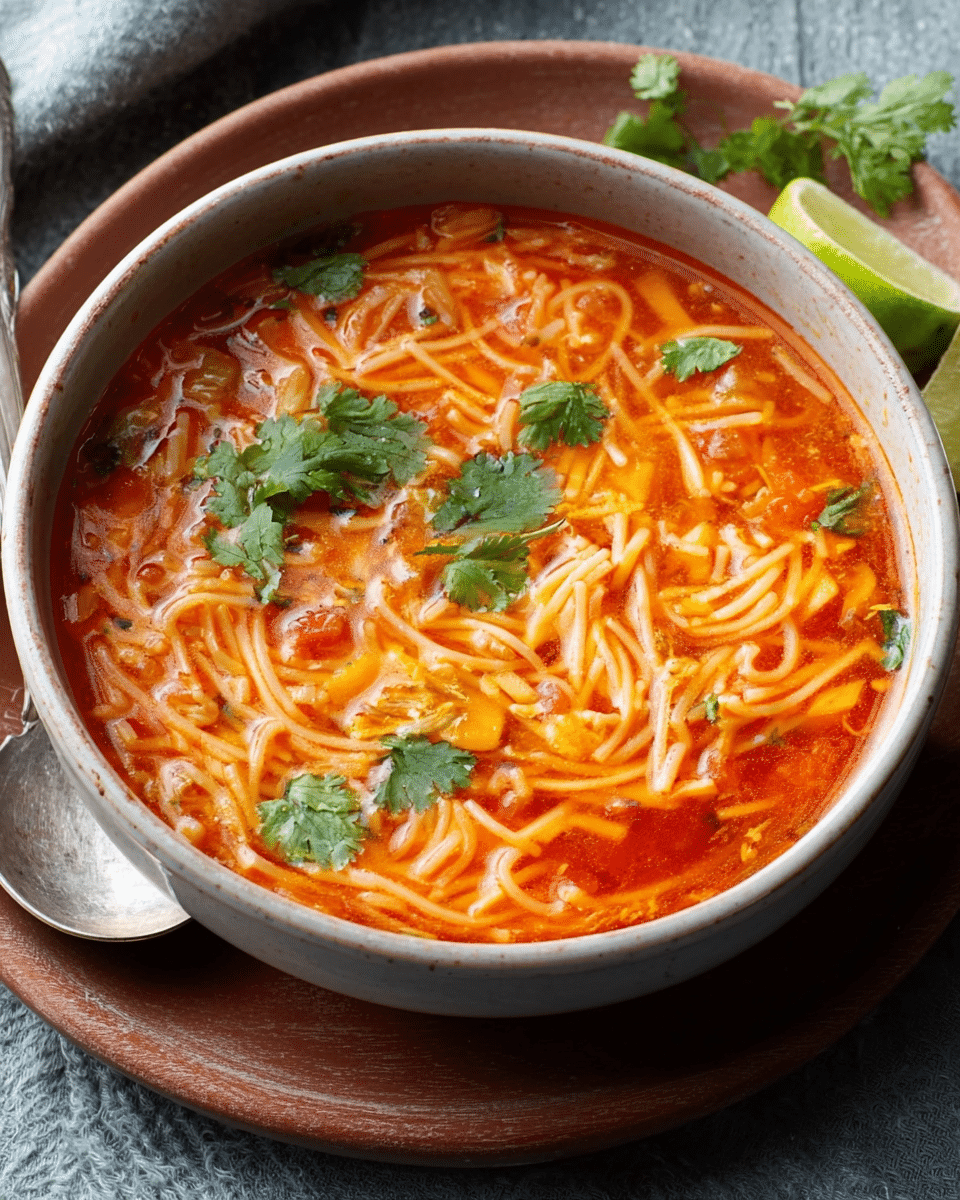Sopa de Fideo is a beloved Mexican comfort food made with thin vermicelli noodles simmered in a rich tomato-based broth. Often served as a starter or light meal, this dish is simple yet flavorful, with a warm, homey taste that’s perfect for any time of the year. The noodles are lightly toasted before simmering, giving the soup a nutty depth of flavor that blends beautifully with aromatic spices and vegetables.
FULL RECIPE
Ingredients
- 7 oz (200 g) fideo noodles or thin vermicelli
- 2 tbsp vegetable oil
- 2 medium tomatoes, chopped
- 1 small onion, chopped
- 2 cloves garlic, minced
- 4 cups chicken broth (or vegetable broth for vegetarian)
- 1 cup water
- 1 tsp ground cumin
- 1 tsp chili powder (optional)
- Salt and pepper to taste
- Fresh cilantro, chopped (for garnish)
- Lime wedges (for serving)
Directions
- In a blender, combine the chopped tomatoes, onion, and garlic. Blend until smooth and set aside.
- Heat the vegetable oil in a large saucepan over medium heat. Add the fideo noodles and toast, stirring constantly, until golden brown, about 3–4 minutes.
- Pour the blended tomato mixture into the pan and cook for 2–3 minutes, allowing the flavors to meld.
- Add the chicken broth, water, cumin, chili powder (if using), salt, and pepper. Stir well.
- Bring the soup to a gentle boil, then reduce the heat to low. Simmer for 10–12 minutes, or until the noodles are tender.
- Taste and adjust seasoning if needed.
- Serve hot, garnished with fresh cilantro and a squeeze of lime juice.
Nutrition Facts
- Calories: 145
- Protein: 4 g
- Fat: 6 g
- Saturated Fat: 1 g
- Carbohydrates: 20 g
- Fiber: 2 g
- Sugars: 3 g
- Sodium: 420 mg
- Cholesterol: 0 mg
Cultural Significance of Sopa de Fideo
Sopa de Fideo holds a cherished place in Mexican culinary tradition, often associated with home-cooked meals and family gatherings. This humble noodle soup is more than just food; it is a symbol of comfort and care. Many people recall their grandmothers or mothers preparing this dish for lunch or dinner, especially during cooler days or when someone in the household needed a soothing, easy-to-digest meal. Its origins can be traced back to Spanish influence, particularly the tradition of fideos, but it has since evolved into a uniquely Mexican recipe with local flavors and techniques. Today, it remains a staple in Mexican homes and is commonly served as the first course in multi-course meals.
Flavor Profile and Texture
The hallmark of Sopa de Fideo’s flavor lies in its rich tomato-based broth and the distinct nuttiness from toasting the noodles before cooking. This simple step creates a deeper, slightly earthy flavor that sets it apart from other noodle soups. The broth is savory, lightly tangy from the tomatoes, and can be seasoned with spices like cumin, chili powder, or oregano for additional depth. The texture of the noodles is tender yet firm enough to hold their shape, absorbing the flavorful broth without becoming mushy. Fresh garnishes like cilantro and lime brighten the dish and provide a refreshing balance to its comforting warmth.
Nutritional Value
Sopa de Fideo offers a moderate nutritional profile, making it a suitable option for a light meal or starter. The noodles provide carbohydrates for quick energy, while the tomato base delivers vitamin C, antioxidants, and lycopene, which supports heart health. Using a chicken or vegetable broth adds a layer of protein and minerals, and incorporating vegetables such as carrots, zucchini, or spinach can increase fiber and micronutrient content. The soup is generally low in fat, especially when prepared with minimal oil, and can be adjusted to suit specific dietary needs by using whole wheat noodles or gluten-free pasta alternatives.
Variations Across Regions
While the classic recipe calls for thin vermicelli noodles and a tomato-based broth, regional variations abound throughout Mexico. In some areas, cooks add chipotle peppers or guajillo chiles for a smoky, spicy twist. Others may include diced vegetables like potatoes, corn, or green beans for added texture and nutrition. In coastal regions, seafood such as shrimp or fish is sometimes incorporated, creating a fusion of flavors. Vegetarian and vegan adaptations use vegetable broth and plant-based garnishes, while more indulgent versions might include shredded chicken or beef for a heartier soup.
Serving Suggestions
Sopa de Fideo is traditionally served hot, often as a first course before the main meal, but it can also be enjoyed as a light lunch or dinner on its own. A squeeze of fresh lime juice at the table enhances the flavors and adds a zesty note. It pairs well with warm corn tortillas, crusty bread, or a simple side salad. For a more complete meal, it can be accompanied by a plate of beans or a small portion of grilled protein such as chicken or fish. Garnishes like avocado slices, crumbled queso fresco, or pickled jalapeños can elevate its presentation and taste.
Ideal Pairings
This soup pairs wonderfully with a variety of traditional Mexican dishes. It can be served alongside tacos, enchiladas, or tamales for a festive spread. Light, citrusy drinks like agua fresca or horchata complement the soup’s flavors, while a mild Mexican lager or non-alcoholic beer can also be a refreshing choice. For a more robust pairing, a smoky mezcal cocktail provides a unique contrast to the soup’s mild sweetness. When served as part of a multi-course meal, Sopa de Fideo works beautifully as a gentle introduction to bolder, spicier main dishes.
Storage and Reheating Tips
Sopa de Fideo stores well in the refrigerator for up to three days, though the noodles may continue to absorb broth and soften over time. To maintain the best texture, some cooks recommend storing the cooked noodles separately from the broth and combining them just before reheating. When reheating, gently warm the soup over medium heat, adding a splash of broth or water if it has thickened too much. It can also be frozen for up to two months, though the noodles may lose some firmness after thawing.
Healthier Preparation Methods
For a lighter version of Sopa de Fideo, consider using whole wheat or gluten-free noodles to boost fiber content and accommodate dietary restrictions. Using a homemade broth allows for better control over sodium levels and can enhance the soup’s depth of flavor. Additional vegetables can be added during cooking for extra nutrients, and the amount of oil used to toast the noodles can be reduced or replaced with a light spray of cooking oil to cut down on fat. Those watching their calorie intake can also reduce portion sizes and serve the soup alongside a protein-rich salad or side dish.
Common Mistakes to Avoid
One of the most frequent mistakes when making Sopa de Fideo is overcooking the noodles, which can cause them to become mushy and lose their appeal. It’s important to keep an eye on cooking time and remove the soup from heat as soon as the noodles are tender. Another error is skipping the toasting step, which is essential for developing the signature flavor. Using low-quality broth can also result in a bland soup, so it’s worth investing in good stock or making it from scratch. Lastly, adding too much lime juice before serving can overpower the delicate tomato base, so it’s best to offer it at the table for individual preference.
Conclusion
Sopa de Fideo is a simple yet deeply satisfying dish that embodies the warmth and hospitality of Mexican cooking. Its straightforward preparation, comforting taste, and adaptability make it a beloved choice for home cooks around the world. Whether served as a nostalgic family recipe, a healthy weekday option, or a flavorful starter for a special meal, it offers nourishment for both body and soul.






